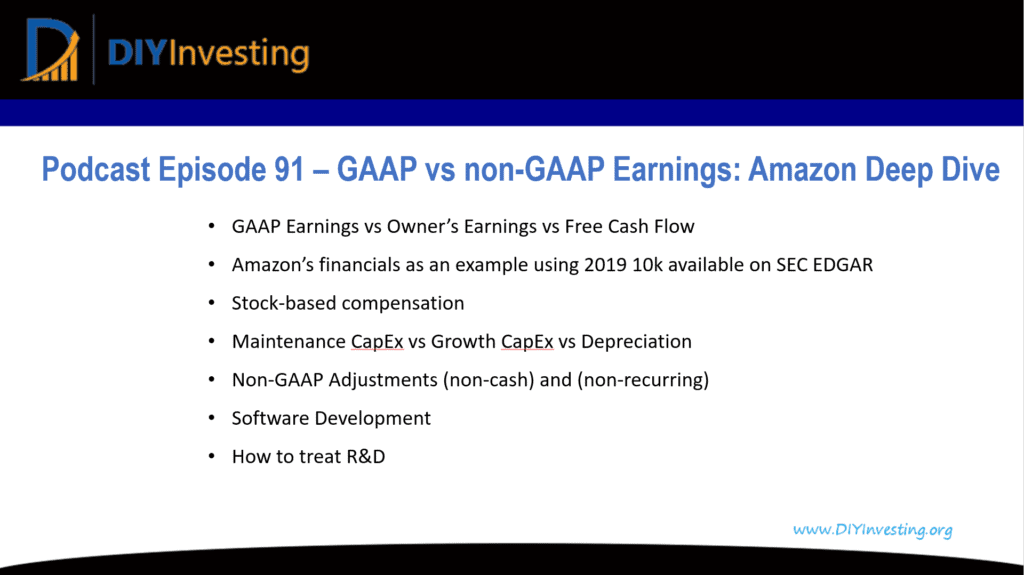Mental Models discussed in this podcast:
- Generally Accepted Accounting Principles (GAAP)
- Owner’s Earnings
- Free Cash Flow
Please review and rate the podcast
If you enjoyed this podcast and found it helpful, please consider leaving me a rating and review. Your feedback helps me to improve the podcast and grow the show’s audience.
Follow me on Twitter and YouTube
Twitter Handle: @TreyHenninger
YouTube Channel: DIY Investing
Support the Podcast on Patreon
This is a podcast supported by listeners like you. If you’d like to support this podcast and help me to continue creating great investing content, please consider becoming a Patron at DIYInvesting.org/Patron.
You can find out more information by listening to episode 11 of this podcast.
Show Outline

Owner’s Earnings definition and its Approximations
- GAAP Earnings vs Owner’s Earnings vs Free Cash Flow
- Everything is an approximation attempt at Owner’s Earnings
- What are the Owner’ earnings?
- The cash available to be distributed from the business TODAY without impacting the competitive position of the business for the future.
- How much cash could be paid in dividends today if the business didn’t grow AND didn’t shrink?
- We’re going to talk about Amazon today
- Using Amazon’s 10k. (2019)
Investing Rules for Fundamental Analysis of GAAP Earnings
- Expenses should be treated as expenses even if they don’t involve cash outlays
- Think like an owner, not a manager
- If your estimate of free cash flow exceeds 110% earnings you’re probably wrong. (Not always but probably).
- It is rare for a company’s free cash flow to exceed earnings.
Stock-Based Compensation
- This is the big one. How you calculate this can be a problem.
- Amazon recorded a $6.8 billion non-cash expense for “stock-based compensation” in 2019.
- Jan 2019 shares: 491.2 million
- Jan 2020 shares: 497.8 million
- An increase in 6.6 million shares during that period. Yet, using Amazon’s market price of $3,200, it would require $21.1 billion to buyback that many shares.
- Should you use $6.8 billion as the expense or $21.1 billion?
- In January 2020, Amazon was priced at $1,800 per share, so let’s use that price. That’s still $11.8 billion to buy back the shares. This means Amazon is understating the cost of its share issuance by AT LEAST $5 billion, in a single year.
Maintenance CapEx vs Growth CapEx vs Depreciation
- It is a fallacy to say that Growth CapEx is simply Total CapEx minus Depreciation.
- Inflation will cause maintenance CapEx to exceed Depreciation in most cases.
- Also, have to consider property plant and equipment acquired under finance leases.
- $13.7 billion in Amazon’s case.
Questions from Twitter
- Valuation Adjustments
- Land
- Inventory
- Investments
- Goodwill is ambiguous
- Deferred revenue classified as a liability (false reading of a firm’s financial condition)
- Response: Pay upfront is useful as a float when growing but harmful when growth reverses.
- May have to pay refunds?
- Change in accounting rules for operating leases (now considered an asset with a matching liability)
- Software and R&D immediately expensed even though it can be an asset like a factory or a machine.
- Non-GAAP adjustments are either (1) non-recurring or (2) non-cash. On (1), can you explain how you factor in non-recurring costs into a forecast for valuation, and (2) how to deal with the amortization of acquired intangibles vs total amortization (ie. incl. Non acquired intangible assets)
- Companies will sometimes only back out acquired intangibles and not amortized internally developed assets.
- Adjusting CAPEX for operating leases.
Summary:
GAAP stands for “Generally Accepted Accounting Principles” and GAAP earnings represent net income available to shareholders using these accepted accounting principles. GAAP is foundational for investors trying to calculate the owner’s earnings.
